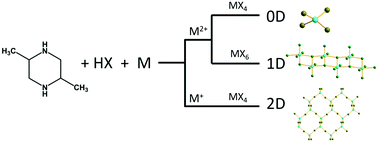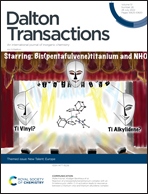Templating effect of trans-2,5-dimethylpiperazine (TDMP) on the structural dimensionality of hybrid metal halides†
Abstract
Templating effects are commonly investigated by comparing different organic structure-directing agents in a specific inorganic system. Herein, a specific secondary diamine, the trans-2,5-dimethylpiperazine, has been selected for different metal halide anions with the aim to analyze its influence on different inorganic networks. Thus, five new trans-2,5-dimethylpiperazine-1,4-diium based compounds with [CuBr4]2−, [CdBr4]2−, [CuBr2]−, [AgCl2]−, and [AgBr2]− have been synthesized, structurally characterized and compared to eight previously reported compounds containing [ZnCl4]2−, [ZnBr4]2−, [CoCl4]2−, [PbCl4]2−, [PbBr4]2−, [SnBr4]2−, [CuCl4]2−, and [CdCl4]2−. Despite the different crystal structures (space-groups, inorganic frameworks, etc.), the dimensionalities (from 0D to 2D) of the inorganic networks of these 13 hybrid materials could be rationalized according to only two parameters: the oxidation state (+1 or +2) and the coordination sphere (tetrahedron or octahedron) of the metal ions. The luminescence properties of the new hybrid silver bromide have been analyzed and discussed by comparing the luminescence mechanisms of the other previously reported trans-2,5-dimethylpiperazine-1,4-diium metal halides.

- This article is part of the themed collection: New Talent: Europe


 Please wait while we load your content...
Please wait while we load your content...